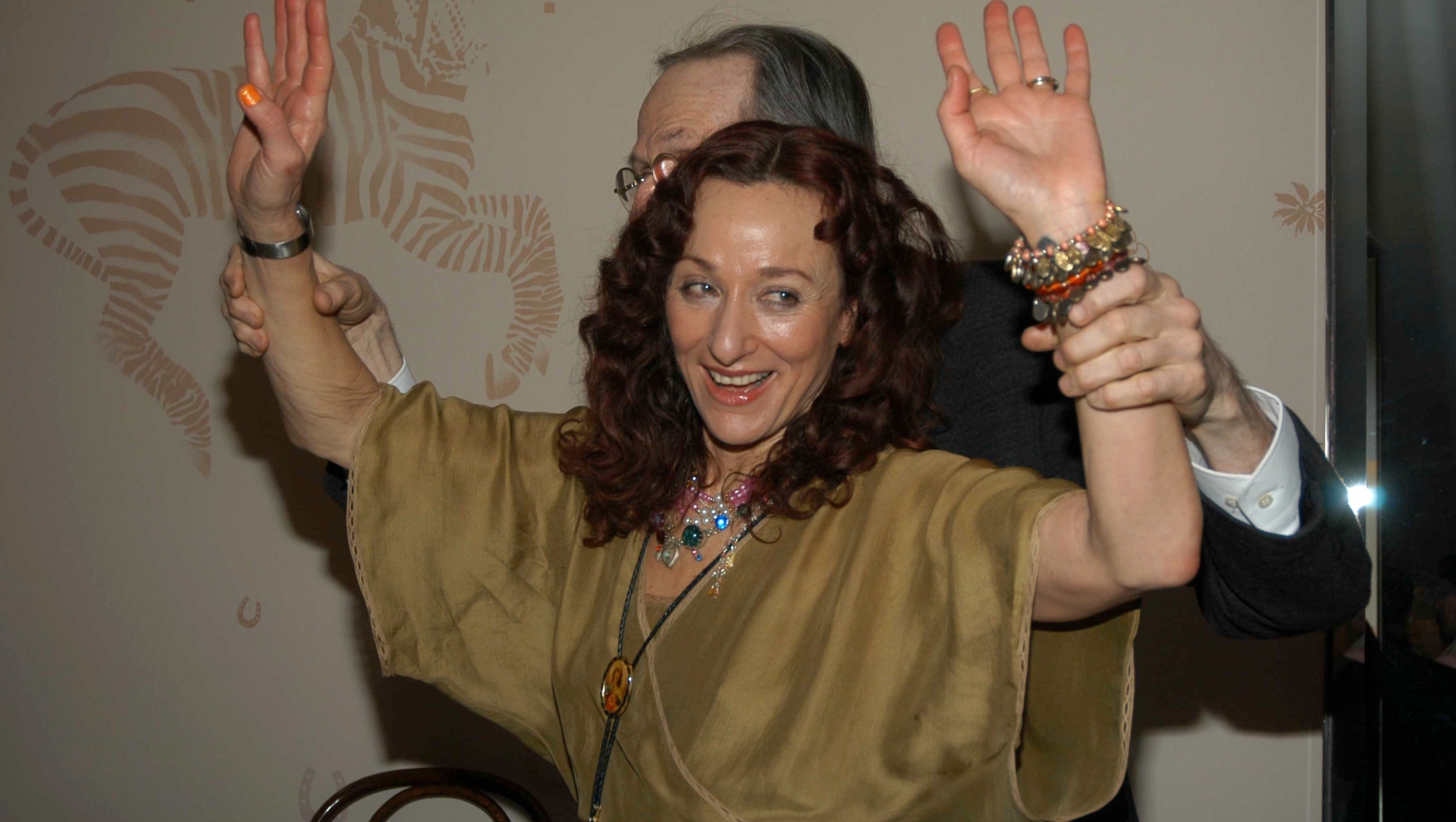Aline Kominsky-Crumb, who transformed comics first as a muse and then as a feminist artist, dies at 74
Aline Kominsky-Crumb brought to comics raw self-lacerating accountability and subverted crude stereotypes about Jewish women

Aline Crumb and Robert Crumb attend A Night at Crumbland celebrating Stella McCartney and Robert Crum Collaboration and the R. Crumb Handbook at the Stella McCartney Store, in New York City, April 12, 2005. (Nick Papananias/Patrick McMullan via Getty Images)
(JTA) — Robert Crumb put the “x” in comix by setting to paper his basest sexual longings, including strong-legged Jewish women who were cowgirls and who went by the name Honeybunch Kaminski.
So when an actual strong-legged Jewish cowgirl named Aline Kominsky walked into his life, it was love at first sight, and never wavered.
Aline Kominsky-Crumb, who died Wednesday at 74 in France of pancreatic cancer, was late to the revolution her husband launched in comics a few years before they met, with his Zap Comix. The “x” was a signifier of what was then known as “underground” comics and referred to the unfiltered treatment of humanity that censorious publishers, politicians and public figures had all but washed out of the art.
She soon fully embraced the art form and then helped transform it.
Working with her husband and then on her own, Kominsky-Crumb brought to comics raw self-lacerating accountability and subverted crude stereotypes about Jewish women — including those peddled by her husband — by taking possession of them.
She started out as a self-acknowledged sex object reviled by second-wave feminists and became a hero of younger feminists for modeling unfettered sexual expression. She was the brassy Jewish stereotype who became the muse who guided her husband to a deeper consideration of Judaism.
Kominsky-Crumb, born Aline Ricky Goldsmith in 1948 in the Five Towns, a Jewish enclave on Long Island, had a Jewish upbringing that was in many ways conventional, horrifying and both at the same time. She wrote about the warmth of her grandparents’ home and how she sought in it succor and about the pressures her materialistic parents placed on her. She said she was named for a Five Towns clothing store, Aline Ricky, that sold French fashion knockoffs. She resisted her mother’s pressure to get a nose job.
In one autobiographical comic, she recalls seeing one Jewish girl after another coming into school after plastic surgery. “Me ‘n’ my friends developed a ‘big nose pride,’” she writes, and one of the characters says, “I could not stand to look like a carbon copy!”
She told fellow Jewish cartoonist Sarah Lightman about the ordeal. “Like, I kept my nose, but it was really a close call, because my mother had me in Doctor Diamond’s office and he measured my nose. I remember that. They took an instrument and measured your nose. And then he took a piece of paper and he said,’ look, we can make it look like this.’ And I said, ‘Oh my God.’ My mother said, ‘Oh, it’s gorgeous, gorgeous.’”
In her teens, Kominsky-Crumb fled the suburbs for Manhattan. She studied at Cooper Union, an art school, and lived on the Lower East Side, earning plaudits from her instructors for her painting, but getting bored. She had a baby and gave it up for adoption to a Jewish agency, an experience that scarred her, and later led her to become outspoken in advocating for abortion rights.
After she married Carl Kominsky, they moved to Tucson, Arizona, which she called “hippie heaven.” There, she left her husband for a cowboy who lived with two brothers and his father in what she said was “the middle of nowhere” where she helped out on horseback, albeit under the influence of hallucinogens. (She said her beau was killed in a shootout with a romantic rival after she left.)
In Tucson, she met two pioneers of underground comics, Kim Deitch and Spain Rodriguez. They encouraged her to move to San Francisco, which was the scene of the burgeoning movement.
She did and met Crumb at a party in 1971, within three years of his having created “Honeybunch Kaminski, the drug-crazed runaway” (1968) and “Dale Steinberger, the Jewish Cowgirl.” Kominsky-Crumb, who had kept her first husband’s last name because it sounded more “ethnic” than Goldsmith, was so taken with the her husband’s lustful Jewish imaginings, and how closely she physically resembled them, that when she started creating her own, she named her avatar “Bunch,” a shortened version of the character whose name most closely matched her own.
It was kismet, except it wasn’t at first. Crumb and Kominsky-Crumb got together, but maintained open relationships. Crumb endured Kominsky-Crumb’s dalliances with other men for decades, but Kominsky-Crumb was not as able (or willing) to reciprocate. When one of Crumb’s exes arrived at their commune in Mendocino, she told The Comics Journal in 1990, she was furious. “I had a total s— fit,” she said, “I was wearing these giant platform shoes. I ran out the door and I fell and broke my foot in six places.”
Crumb sent the ex on her way and entertained the recovering Kominsky with a pastime he and his brother worked out as children: They would co-create a comic.
That process drew the couple closer, and also became a decades-long unflinching chronicle of a relationship. A culmination, “Drawn Together,” was critically acclaimed when it came out in 2012.
In one passage in the 2012 book, she gently chides her husband for resorting to antisemitic tropes — although it was tropes about loud, slightly unhinged, sexually voracious Jewish women that drew them together.
One page depicts the couple in bed. Crumb is stung by an accusation of antisemitism from Art Spiegelman. (Spiegelman joined with Crumb to launch the underground comics scene in the 1960s, but they grew apart as Spiegelman, who would author the Holocaust chronicle “Maus,” sought to attach an overarching philosophy to the genre, while Crumb continued to crave crude authenticity.)
Crumb says that Spiegelman “seems to be taking my ruminations about the Jews as antisemitism … I certainly didn’t mean it as such.” Kominsky-Crumb draws herself into the panel, listening to her husband, as a little girl wearing tefillin, a T-shirt with “kosher” in Hebrew and a Star of David pendant. In the next panel, once again appearing as a grown woman in a negligee, she makes clear to Crumb why she feels vulnerable as a Jew in the marriage.
“Dahling, you do call the Jewish religion ‘Brand X’,” she says.. “Now I might even think that’s true in some ways … and I’m one o’ them … I’m allowed to say that!”
Crumb draws himself as wounded but also awakened. “Oh, I see … ulp.” Crumb dedicated his masterwork, “The Book of Genesis,” a searing illustrated narrative of the Bible’s first book, to Aline.
The Crumbs’ collaborative work was celebrated among aficionados, but it wasn’t until 1994’s “Crumb,” a documentary directed by Crumb’s close Jewish friend, Terry Zwigoff, that she emerged into the broader culture. A vibrant, peripatetic Kominsky-Crumb cares for their daughter, Sophie, and revels in their life in a small French village, where they had moved a few years earlier, while Crumb continues to hold back, playing the wounded, misunderstood artist.
It was an arrival of sorts for Kominsky-Crumb. She had for a time been marginalized even on the underground scene, her deceptively simple art derided as sloppy. She helped found the Wimmen’s Comix collective in 1972, and wrote about her Jewish upbringing in the first issue, a piece entitled “Goldie: A Neurotic Woman.” But she was soon frozen out because some of her colleagues thought her musings about longing to be dominated (and her tendency to dress that way to please Crumb) were denigrating to women. “The Yoko Ono of Comics,” is how the New York Times described her early years.
She left the collective and joined another Jewish woman artist, Diane Noomin, in launching “Twisted Sisters” in 1976. Its cover depicts hers seated on a toilet wondering “How many calories in a cheese enchilada.” The message to her erstwhile colleagues, who depicted women heroically, was clear: Kominsky-Crumb would indulge her full unvarnished self.
It would take decades, but a later generation of feminists would come to understand her autobiographical “Bunch” not as a self-loathing caricature but as a means of understanding ones whole self. In 2020, Lightman launched an interview with Kominsky-Crumb by reviewing a 1975 cartoon, “Bunch plays with herself” that shocked even the underground scene at the time with its graphic depictions of a woman exploring every corner of her body.
“I didn’t do it to be disgusting but it’s, like, about every horrible and fun thing you can do with your body,” Kominsky-Crumb told Lightman. “I think it’s an amazing piece of feminist art,” Lightman said in the interview, “because women are drawn to be gazed at, and [here we see] their bodily juices, and everything. … The last panel is the best. ‘My body is an endless source of entertainment’.”
In 2007, she and Crumb created a cover for the Jewish counterculture magazine Heeb, where she is cradling him in her arms. “”I feel so safe in the arms of this powerful Jewish woman!” Crumb says.
By 2018, she was scrolling through her phone to show a New York Times reporter pictures of Crumb cavorting with the grandkids. (Daughter Sophie in adulthood also is a comics artist.) The photos then transition to photos of women’s behinds, taken in Miami.
“I’m enabling his big butt fixation,” she said. “Well I don’t have a big butt anymore so I have to offer him something.”
“It was her energy that transformed the American Crumb family into a Southern French one, with her daughter Sophie living, marrying and having three French children there,” the official Crumb website said in announcing her death. “She will be dearly missed within that family, by the international cartooning community, but especially by Robert, who shared the last 50 years of his life with her.”
This article originally appeared on JTA.org.




















